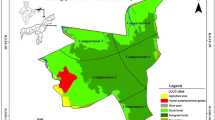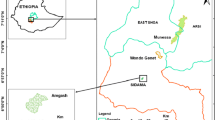Abstract
We investigated diet and feeding behavior of the acrobatic cavy Kerodon acrobata, a rare caviomorph rodent endemic from the Cerrado (Brazilian savannah). We tested whether its trophic niche breadth varies between seasons and whether this species shows seasonal differences in food resource use. Feeding behavior was observed through observations of foraging activities in dry forest associated with limestone outcroppings in central Brazil. K. acrobata showed a generalist diet, feeding on leaves from at least 16 native plant families, also consuming flowers and fruits collected directly from plants or litterfall as well as branches, sprouts, and bark. The diversity of feeding behavior categories did not differ significantly between rainy and dry seasons. The trophic niche breadth considering the plant species consumed, however, decreased during the dry season, when this rodent relied mainly on fallen flowers of Handroanthus serratifolius (Caricaceae; about 44 % of the identified feeding records). The diet of the acrobatic cavy was influenced by the availability of falling leaves and flowers during the dry season, when the animals focused their foraging activities on litterfall. The animals seemed not to extend their behavioral repertoire of foraging in the dry season; instead, they seasonally changed their resource exploitation strategy by altering the proportions of items used and the plant species consumed. The trophic niche breadth and plastic feeding behavior of the acrobatic cavies may explain their persistence in disturbed habitats. Their close relationship with the forests studied indicates the vulnerability of K. acrobata to activities that may threaten the integrity of dry forest areas.



Similar content being viewed by others
References
Baxter R, Hansson L (2001) Bark consumption by small rodents in the northern and southern hemispheres. Mammal Rev 31:47–59. doi:10.1046/j.1365-2907.2001.00078.x
Begon M, Townsend CR, Harper JL (2005) Ecology—from individuals to ecosystems, 4th edn. Blackwell Publishing, Oxford
Bezerra AM, Bonvicino CR, Menezes AA, Marinho-Filho J (2010) Endemic climbing cavy Kerodon acrobata (Rodentia: Caviidae: Hydrochoerinae) from dry forest patches in the Cerrado domain: new data on distribution, natural history, and morphology. Zootaxa 2724:29–36
Bianchi CA, Haig SM (2013) Deforestation trends of tropical dry forests in central Brazil. Biotropica 45:395–400. doi:10.1111/btp.12010
Camargo NF, Ribeiro JF, Camargo AJA, Vieira EM (2014) Intra- and inter-individual variation show distinct trends as drivers of seasonal changes in the resource use of a neotropical marsupial. Biol J Linn Soc 11:737–747. doi:10.1111/bij.12258
Campos CM, Ojeda R, Monge S, Dacar MA (2001) Utilization of food resources by small and medium-sized mammals in the Monte Desert biome, Argentina. Austral Ecol 26:142–149
Cardoso MRD, Marcuzzo FFN, Barros JR (2015) Classificação climática de Köppen-Geiger para o estado de Goiás e o Distrito Federal. Acta Geográfica 8:40–55
Charnov EL (1976) Optimal foraging: attack strategy of a mantid. Am Nat 110:141–151
Dearing MD, Mangione AM, Karasov WH (2000) Diet breadth of mammalian herbivores: nutrient versus detoxification constraints. Oecologia 123:397–405. doi:10.1007/s004420051027
Felfili JM, Carvalho FA, Haidar RF (2005) Manual para o monitoramento de parcelas permanentes nos biomas Cerrado e Pantanal. Universidade de Brasília, Departamento de Engenharia Florestal, Brasília
Felfili JM, Nascimento ART, Fagg CW, Meirelles EM (2007) Floristic composition and community structure of a seasonally deciduous forest on limestone outcrops in Central Brazil. Rev Bras Bot 30:611–621. doi:10.1590/s0100-84042007000400007
Freeland W (1974) Vole cycles: another hypothesis. Am Nat 108:238–245. doi:10.1086/282905
Freeland WJ, Janzen DH (1974) Strategies in herbivory by mammals: the role of plant secondary compounds. Am Nat 108:269–289. doi:10.1086/282907
Galende GI, Raffaele E (2012) Diet selection of the southern vizcacha (Lagidium viscacia): a rock specialist in north western Patagonian steppe, Argentina. Acta Theriol 57:333–341. doi:10.1007/s13364-012-0078-9
Gill R (1992) A review of damage by mammals in north temperate forests. 2. Small mammals. Forestry 65:281–308. doi:10.1093/forestry/65.3.281
Glander KE (1977) Poison in a monkey’s Garden of Eden. Veneno en el Jardín del Edén de los monos. Nat Hist 86:35–41
Hammer Ø, Harper D, Ryan P (2001) PAST-PAlaeontological STatistics. www.uv.es/~pardomv/pe/2001_1/past/pastprog/past.pdf. Accessed 25 June 2009
Kie JG (1999) Optimal foraging and risk of predation: effects on behavior and social structure in ungulates. J Mammal 80:1114–1129. doi:10.2307/1383163
Krebs CJ (1999) Ecological methodology, 2nd edn. Benjamin/Cummings Menlo Park, California
Lacher TE (1981) The comparative social behavior of Kerodon rupestris and Galea spixii and the evolution of behavior in the Caviidae. Bull Carnegie Mus Nat Hist 120:297–316
Langguth A, Reis M (2008) Kerodon acrobata. The IUCN red list of threatened species. Version 2015.2. http://www.iucnredlist.org/details/136222/0. Accessed 25 June 2015
Lima SL, Dill LM (1990) Behavioral decisions made under the risk of predation: a review and prospectus. Can J Zool 68:619–640. doi:10.1139/z90-092
MacArthur RH, Pianka ER (1966) On optimal use of a patchy environment. Am Nat 100:603–609
Mares MA, Lacher TE Jr (1987) Ecological, morphological, and behavioral convergence in rock-dwelling mammals. In: Genoways HH (ed) Current mammalogy, vol 1. Plenum Publishing Co, New York, pp 307–348. doi:10.1007/978-1-4757-9909-5_8
Marsh KJ, Moore BD, Wallis IR, Foley WJ (2014) Feeding rates of a mammalian browser confirm the predictions of a ‘foodscape’ model of its habitat. Oecologia 174:873–882. doi:10.1007/s00442-013-2808-3
MMA – Ministério do Meio Ambiente (2008) Lista Nacional das Espécies da Flora Brasileira Ameaçadas de Extinção. Instrução Normativa MMA n° 06, de 23 de setembro de 2008. Brasília
MMA – Ministério do Meio Ambiente (2014) Lista Nacional Oficial de Espécies da Fauna Ameaçadas de Extinção. Portaria N° 444, de 17 de dezembro de 2014. Diário Oficial da União, n. 245, Seção 1, Brasília, pp 121–126
Moojen J, Locks M, Langguth A (1997) A new species of Kerodon Cuvier, 1825 from the state of Goiás, Brazil (Mammalia, Rodentia, Caviidae). Bol Mus Nac (n s) Zool, Rio de Janeiro 377:1–10
Moore BD, Lawler IR, Wallis IR, Beale CM, Foley WJ (2010) Palatability mapping: a koala’s eye view of spatial variation in habitat quality. Ecology 91:3165–3176. doi:10.1890/09-1714
Nascimento ART, Felfili JM, Meirelles EM (2004) Florística e estrutura da comunidade arbórea de um remanescente de Floresta Estacional Decidual de encosta, Monte Alegre, GO, Brasil. Acta Bot Bras 18:659–669. doi:10.1590/s0102-33062004000300023
Oliveira JA, Bonvicino CR (2006) Ordem Rodentia. In: Reis NR, Peracchi AL, Pedro WA, Lima IP (eds) Mamíferos do Brasil. Universidade Estadual de Londrina, Londrina, pp 347–406
Paglia AP, Fonseca GAB, Rylands AB, Herrmann G, Aguiar LMS, Chiarello AG, Leite YLR, Costa LP, Siciliano S, Kierulff MCM, Mendes SL, Tavares VC, Mittermeier RA, Patton JL (2012) Lista anotada dos mamíferos do Brasil 2ª Edição Annotated checklist of Brazilian mammals. Occasional Papers in Conservation Biology, vol 6. Conservation International, Arlington
Ribeiro JF, Walter BMT (1998) Fitofisionomias do bioma cerrado. In: Sano SM, Almeida SP (eds) Cerrado Ambiente e Flora. EMBRAPA-CPAC, Planaltina, pp 89–166
Roberts M, Maliniak E, Deal M (1984) The reproductive biology of the rock cavy, Kerodon rupestris, in captivity: a study of reproductive adaptation in a trophic specialist. Mammalia 48:253–266. doi:10.1515/mamm.1984.48.2.253
Sassi PL, Borghi CE, Bozinovic F (2007) Spatial and seasonal plasticity in digestive morphology of cavies (Microcavia australis) inhabiting habitats with different plant qualities. J Mammal 88:165–172. doi:10.1644/06-mamm-a-046r1.1
Sassi P, Borghi C, Dacar M, Bozinovic F (2011) Geographic and seasonal variability in feeding behavior of a small herbivorous rodent. Acta Theriol 56:35–43. doi:10.1007/s13364-010-0007-8
Silva LÁ, Scariot A (2004) Comunidade arbórea de uma floresta estacional decídua sobre afloramento calcário na Bacia do rio Paraná. Rev Árvore 28:61–67. doi:10.1590/S0100-67622004000100008
Silvando CS, Santana NMP, Pelegrini JC (2006) Caracterização climática estado de Goiás – Série Geologia e Mineração, n 3. Secretaria de Indústria e Comércio, Superintendência de Geologia e Mineração, Goiânia
Smythe N (1986) Competition and resource partitioning in the guild of neotropical terrestrial frugivorous mammals. Annu Rev Ecol Syst 17:169–188. doi:10.1146/annurev.ecolsys.17.1.169
Stephens DW, Krebs JR (1986) Foraging theory. Princeton University Press, Princeton
Stephens SA, Salas LA, Dierenfeld ES (2006) Bark consumption by the painted Ringtail (Pseudochirulus forbesi larvatus) in Papua New Guinea. Biotropica 38:617–624. doi:10.1111/j.1744-7429.2006.00197.x
Swihart RK, Gehring TM, Kolozsvary MB, Nupp TE (2002) Responses of ‘resistant’ vertebrates to habitat loss and fragmentation: the importance of niche breadth and range boundaries. Divers Distrib 9:1–18. doi:10.1046/j.1472-4642.2003.00158.x
Vieira MV (2003) Seasonal niche dynamics in coexisting rodents of the Brazilian Cerrado. Stud Neotropical Fauna Environ 38:7–15. doi:10.1076/snfe.38.1.7.14034
Westoby M (1978) What are the biological bases of varied diets? Am Nat 112:627–631. doi:10.1086/283303
Wiggins NL, McArthur C, Davies NW (2006) Diet switching in a generalist mammalian folivore: fundamental to maximising intake. Oecologia 147:650–657. doi:10.1007/s00442-005-0305-z
Zar JH (1999) Biostatistical analysis. Prentice Hall, New Jersey
Acknowledgments
While conducting this research, ASP received a scholarship from the Conselho Nacional de Desenvolvimento Científico e Tecnológico (CNPq), Brazil (No 140999/2011-6), and also a student research grant from the Decanato de Pesquisa e Pós-Graduação (DPP-UnB), and EMV also received a personal research grant (“productivity” grant) from CNPq (No 308992/2013-0). We would also like to thank the farm owners where the study was conducted and Aryanne G. Amaral, Maria Rosa V. Zanatta, Jair E. Q. Faria Júnior, and Fernando C. Vieira for identifying the plant species.
Author information
Authors and Affiliations
Corresponding author
Additional information
Communicated by: Thales Renato Ochotorena de Freitas
Appendix
Appendix
Rights and permissions
About this article
Cite this article
de Souza Portella, A., Vieira, E.M. Diet and trophic niche breadth of the rare acrobatic cavy Kerodon acrobata (Rodentia: Caviidae) in a seasonal environment. Mamm Res 61, 279–287 (2016). https://doi.org/10.1007/s13364-016-0275-z
Received:
Accepted:
Published:
Issue Date:
DOI: https://doi.org/10.1007/s13364-016-0275-z




